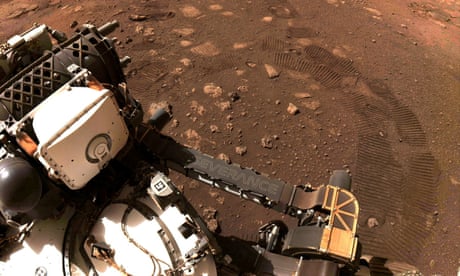- by foxnews
- 20 Jan 2025
Nasa’s Moxie instrument successfully makes oxygen on Mars
Nasa’s Moxie instrument successfully makes oxygen on Mars
- by theguardian
- 01 Sep 2022
- in news

An instrument the size of a lunchbox has been successfully generating breathable oxygen on Mars, doing the work of a small tree.
Since February last year the Mars oxygen in-situ resource utilisation experiment, or Moxie, has been successfully making oxygen from the red planet's carbon dioxide-rich atmosphere.
Researchers suggest a scaled-up version of Moxie could be sent to Mars, to continuously produce oxygen at the rate of several hundred trees, ahead of humans going to the planet.
Moxie touched down on the Martian surface as part of Nasa's Perseverance rover mission.
In a study researchers report that by the end of 2021 Moxie was able to produce oxygen on seven experimental runs, in a variety of atmospheric conditions, including during the day and night, and through different Martian seasons.
In each run it reached its goal of producing 6g of oxygen per hour - similar to the rate of a modest tree on Earth.
It is hoped that at full capacity the system could generate enough oxygen to sustain humans once they arrive on Mars, and fuel a rocket to return humans to Earth.
Moxie deputy principal investigator Jeffrey Hoffman, a professor of the practice in Massachusetts Institute of Technology's (MIT) Department of Aeronautics and Astronautics, said: "This is the first demonstration of actually using resources on the surface of another planetary body, and transforming them chemically into something that would be useful for a human mission."
The current version of the instrument is small by design in order to fit aboard the Perseverance rover, and is built to run for short periods. A full-scale oxygen factory would include larger units that would ideally run continuously.
So far, Moxie has shown that it can make oxygen at almost any time of the Martian day and year.
Michael Hecht, principal investigator of the Moxie mission at MIT's Haystack Observatory, said: "The only thing we have not demonstrated is running at dawn or dusk, when the temperature is changing substantially.
"We do have an ace up our sleeve that will let us do that, and once we test that in the lab, we can reach that last milestone to show we can really run any time."
If the system can operate successfully despite repeatedly turning on and off, this would suggest a full-scale system, designed to run continuously, could do so for thousands of hours.
Hoffman said: "To support a human mission to Mars, we have to bring a lot of stuff from Earth, like computers, spacesuits, and habitats.
"But dumb old oxygen? If you can make it there, go for it - you're way ahead of the game."
The findings are published in the journal Science Advances.
- by foxnews
- descember 09, 2016
Travel tips for attending Trump's inauguration in DC: expert weighs in
Washington, D.C., has been gearing up for travelers ahead of Inauguration Day on Jan. 20, bringing Americans to the nation's capital as President-elect Trump returns to the White House.
read more


